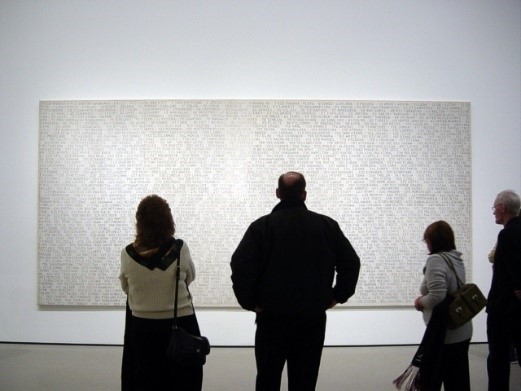
Alighiero Boetti, The Thousand Longest Rivers of the World, (1976-82)/ embroidery on cotton and linen (251.5 x 535.9 cm), Museum of Modern Art (photo Walk the Arts)
Denotation and connotation
As an artist, you have always to remember that a work of art connotes and denotes.
Denotation refers to the literal or explicit sense of a word. It is the first definition provided by a dictionary. Connotation refers to the various subjective meanings resulting from affective associations suggested by a word. In our case, for an image or a painting, the denotation corresponds to the question: What do you see in this image? The connotation relates to the question: What does this image evoke in me?
Let’s take for example, the word “river”. A web dictionary denotes it as: “A large natural stream of water emptying into an ocean, lake, or other body of water and usually fed along its course by converging tributaries”. But a river is also a cultural thing, therefore susceptible of evoking different meanings according to the particular context of each individual.
A clever work that demonstrates perfectly the notions of denotations and connotations is Alighiero Boetti’s embroidery entitled The Thousand Longest Rivers of the World. This piece, which I see every March at the MoMa during New York Art Trip, lists the world’s longest rivers in descending order.
First, our brain takes care of the denotation; we know each word refers to a “river”. Second, the connotation or connected sentiment arises according to the observer’s cultural background. Therefore, the experience is different to each spectator. It is easy for Egyptian or Brazilian spectators to find their mythical and winding rivers Nile and Amazon rivers marked at the very top of the work, while for Canadians, it takes a bit longer to find their majestic and cold Saguenay located somewhere in the middle of this huge work of art. Mythical, winding, majestic and cold are all connotative meanings or in other words, subjective associations that arise from the observer’s
personal perspective. Moreover, this brilliant work motivates viewers from all over the world to find out if a particular river from their country of origin is part of the tapestry. Therefore, feelings of pride and nationalism contribute to the connotative strength of this work of art.
The next time you paint or photograph, think of these two important notions. To conclude, do the same exercise with the following paint by number swans found on eBay. What are the connotations associated with this image? I am letting you answer this question.




Bonjour,
Toujours intéressante.
Merci,
Shari